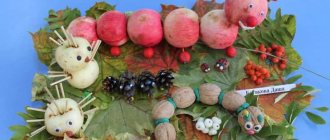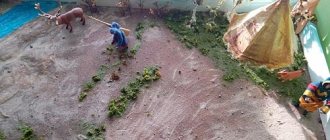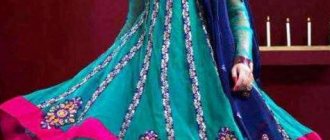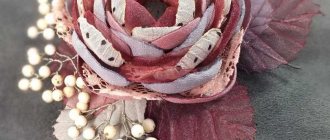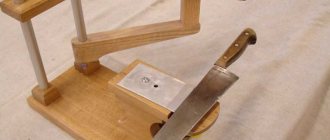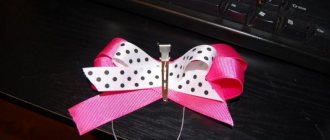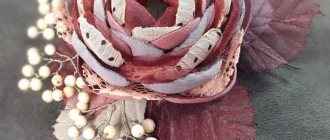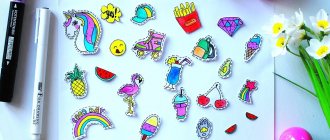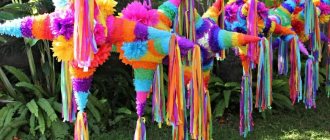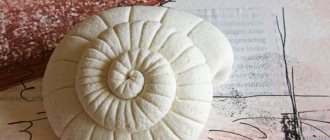Flowers from pine cones
Materials:
- Pine cones
- Dry twigs
- Acrylic paints
- Glue gun
- Colored paper.
Progress:
- Paint the materials in the desired colors, wait until completely dry.
- Using hot glue, attach the stem to the flower.
- Add some construction paper leaves.
Paper ant step by step
The sizes are arbitrary, it all depends on the desired size of the ant. Cut one wider rectangle - for the body as a cylinder, and the second - a narrow and small rectangle or even a strip - for the head. The third, very small stripe will be the neck, and at the same time a part for fastening the head and body together.
Roll the first two strips into rolls and glue the edges together. At this stage, that is, before gluing, you can coordinate the sizes and cut off the excess so that the head is not too large or the body is too long.
Glue a larger strip in the middle of the roll, and attach the head to it.
Cut out two circles from black cardboard (you can also use paper here), a little wider than the body. Sharpen one of the circles on one of the sides.
From black cardboard, cut 8 thin strips that will be the ant's paws and whiskers.
Glue the circles one on top of the other, and then on the roll body. Also glue the paws to the bottom of the body, making bends closer to the tips, imitating the paws of an insect. Attach the antennae to your head and also bend them a little. Eyes can be purchased, or cut out of paper. In this version, a very simple method: on white paper with a black felt-tip pen, draw two connected circles, put dots in the middle of them. And then cut out the drawn eyes, but not along the contour of the drawing, but a millimeter around it.
This is how an ant turned out from paper; if it is made from cardboard, then it is stable on the surface, the body is strong, the legs do not move apart.
More on the topic: DIY insects: insect crafts for children Plasticine ant: step-by-step modeling for children
Do-it-yourself formicarium for ants of the “Tower” type
Next, it was necessary to decide on the design of the cameras and passages, as well as in what form it would all look at the final stage of assembly. In the end, I decided to pour it floor by floor, pouring sand between the floors, and in order for the floors to be supported by something, it was necessary to provide a central column. Go:
prepared a structure for pouring gypsum with a wooden rod inside for the strength of the future column.
At the same time, we fill the first floor of our formicarium with the same plaster
Next, before the plaster hardens, we carefully fix our column and wait for it to dry completely.
Next, fill in regular aquarium sand and fill in a new layer... and so on until the very top of our formicarium
Now we boldly turn our formicarium over and take out our filling with light taps. We wash away the sand and make holes along the column between the floors with a 5 mm drill. So that our ants can move along the column without obstacles.
The result was something beautiful and durable, thanks to the wooden reinforcement in the center of the column
Of course, during the manufacturing process many mistakes and mistakes were revealed, but these are minor things.
Features of paper insects
A paper ant, like all other insects, can not only brighten up an activity, but also serve as an excellent prop at certain moments. You just need to use your imagination to make the crafts as useful as possible.
Where can crafts on this topic come in handy?
Any crafts, including origami ants, will be needed in all situations where there are children. It can be:
If parents want to entice their child to play, it is recommended that they make the craft themselves first.
How to make an ant
As already mentioned, there are several techniques for making an ant with your own hands from paper. When choosing, you just need to read the instructions in detail.
Required materials and tools
To work, you will need to collect materials and tools. They do this after the child has decided on the type of craft. In general, the following tools and materials may be required:
You should collect all tools and materials before work, so as not to be distracted from the process in the future.
For children who are just learning to work with scissors, it is better to choose varieties with a spring. They help your baby cut out pieces by lifting his thumb.
Master class: “Anthill model, for a preschool educational institution site.”
Description of the presentation by individual slides:
Master class: “Anthill model, for a preschool educational institution site.” Made the presentation: Zhukovskaya S.I.
Relevance: What could be more interesting and meaningful for a preschooler than games? At each stage of preschool childhood, play has its own characteristics. Of great importance in the development of play activity of older preschoolers is prototyping and the creation of mock-up models. Purpose: When making mock-ups, the teacher can closely interact with the families of the students. Particularly interesting is the joint production of mock-up models. Tasks: in the process of implementing layouts, several tasks are solved simultaneously and in parallel: consolidating and generalizing children’s knowledge on a particular topic; activation of the lexical vocabulary; development of monologue and coherent speech; development of logical thinking, memory, attention, imagination, fantasy; development of writing skills; development of general and fine motor skills of the hands; formation of creative abilities; education of goodwill; development of communication skills; ability to work in a team.
How to make a funny ant on a stick
The master class is devoted to making a funny toy - a paper ant on a stick. It can be set in motion by simply rotating the wooden skewer on which it is attached.
To make such an ant we will prepare:
First, cut a strip measuring 27x7 cm from a sheet of black paper.
Glue its edges together to create a ring. This will be the main blank for the ant's body.
Then we cut out 2 more strips measuring 5x12 cm and 6x20 cm. We will use them to make a smaller part of the body and the head.
We form rings from these black stripes.
Now let's start assembling the craft. Additionally, you need to cut a strip of 5x14 cm. We begin to glue the parts onto it. First we fix the head.
After this, we glue the blanks for the body. Additionally, we connect all these elements together using PVA glue.
For the ant's paws, we prepared 6 strips 16 cm long and about 1 cm wide.
First, fold the strip in half.
Then we bend its ends to the sides.
In this way we prepare all 6 legs.
We turn the ant blank over and begin gluing the legs.
You need to glue 3 legs on each side.
Now we will glue a wooden stick, cover it on top with a strip of black paper, and fix it with glue.
Master class on making an ant and an anthill “Our Little Friends” from waste material
Aida Emelyanova
Master class on making an ant and an anthill “Our Little Friends” from waste material
Author: teacher Emelyanova Aida Aleksandrovna
Master class on making an ant and an anthill.
Creating conditions for professional self-improvement of teachers in the field of using constructive activities in working with children of senior preschool age.
1. To acquaint the participants of the master class with the experience of using design techniques with waste materials in working with children of senior preschool age.
2. Demonstrate experience in using a step-by-step technique for the practical production of an ant and an anthill .
3. Contribute to the development of professional creative activity, the disclosure of the internal potential of each teacher, by means of organizing experience in the practical application of technology.
Audience: teachers and jury members.
Equipment: plastic caps, PVA glue, sheet of paper, pencil, acrylic gouache, cotton swabs, Kinder surprise egg, double-sided tape, glue brush, paint brush, plastic eyes, scissors, foam blank for our anthill, green threads , tree bark small pieces, twigs, tea.
Description of the ant craft
Perhaps it never even occurred to you that you can make an ant from acorns, twigs and glue. This will take time and your desire, but in the end we will get a wonderful model that can easily be put on a shelf. The most difficult part here will not be following this tutorial step by step, but collecting the acorns. Although if there are park areas, the task becomes somewhat easier. Combining a pleasant walk with children along with a set of necessary materials will be useful for the whole family.
Explain to the kids what you would like to do with them. We are sure that in return you will hear approval from them. To make the craft even more expressive, do it together as an example. Children will watch and observe you, repeating the steps of your steps. Since they may have never encountered anything like this before, implementation may cause some difficulties. If you have some materials left over later, you can think about what other insects you could make. Everything is not as complicated as it seems, the main thing is to familiarize yourself with the technique described below.
Master class on making a model “Anthill”
Svetlana Vasilyeva
Master class on making a model “Anthill”
I would like to introduce you to the step-by-step production of the “ Anthill ” layout. How did it all start? During the implementation of the project “Our Insect Neighbors”. This project was interesting and exciting. Children got acquainted with the life of insects with interest through NNOD, conversations, and games. But we saw that we lack visual material that we can look at, touch with our hands, and in the making of which children can take part. When the children helped Maya the bee in her trouble and sculpted ants , they had a question: “Where will they live? Do they need an anthill ? So the anthill became the product of our project.
We completed the layout in stages : first we took a five-liter plastic bottle, cut it in half and applied polyurethane foam to half.
We cut black, brown, green threads and sticks.
So we have prepared all the material for work.
Then, using glue and thread, the children began to create the shape of an anthill .
Added pebbles and sticks.
Green threads were sprinkled on glue around the anthill
Decorated the grass with flowers. butterflies made of corrugated paper and the children settled their ants in the anthill .
The resulting visual aid will be very useful both in NNOD and will diversify the occupancy of a corner of nature.
Master class on making a model of “Streets of our city” By the beginning of the school year, there was a need to update the model of “Streets of our city”. I found color pictures of buildings on the Internet. Master class on making an aquarium model Now it’s time to make an aquarium for a corner of nature. True, we can’t have a real aquarium; we had to make one from scraps. Master class on making a model “Village Compound” Master class on making a model “Village Compound” At an early age, the child intensively gets acquainted with the world around him: different. Master class on making a “Swans on a Pond” model from natural materials Autumn is a great time to create crafts from natural materials. I propose to make a model of a pond with waterfowl. Material:. Master class on making a model for the traffic rules “City” for the younger group Last year, when our garden just opened, together with the beginning of the school year, we began to replenish the development environment. There are many ideas and tasks. Master class on making a model “Russian Izba” To familiarize children with Russian life, how and where Russian people lived many years ago, I decided to make a model. I took it to make it.
Source
DIY New Year's masquerade mask made of papier-mâché: master class
Papier-mâché is a unique technique that allows you to create a mask that is as close as possible to the contours of your face. However, not everyone is ready to use their own face as a basis. In this case, special blanks are used. For example, made of plastic. This is exactly the kind of master class we will consider.
An alternative to a ready-made mask base is to make your own from foil. Fold the material in several layers and apply it to your face to give it shape. Then make cutouts for the eyes and nose.
- mask blank;
- PVA glue;
- paper egg carriage;
- decorative three-layer napkins;
- white putty;
- scissors;
- brushes, paints, elements for decoration.
We take honeycombs for eggs without labels and crush them into crumbs. Soak in water for 1 day.
After a day, transfer the “pulp” from the cardboard to another container.
Squeeze out the liquid. Squeeze out the paper pulp and grind it into crumbs again.
Then slowly pour in the glue while kneading the cardboard mixture.
Coat the inner surface thoroughly with thick cream. This will ensure good tenacity with the paper mass, which we then lay out in a thin layer. Also, a frozen mask will be easier to remove from a greased mold.
Let it dry. At least a day. It is advisable to leave the workpiece near heating appliances.
Remove the completely dried layer from the plastic base.
Next, you need to putty the layer.
And we decorate it at our discretion.
For the test you will need:
- 2 cups of flour;
- a glass of salt;
- 2 tablespoons of citric acid. Approximately 15 grams, this is no less than a pack;
- 2 glasses of water;
- 4 tablespoons of vegetable oil;
- half a cup of cocoa powder or any food coloring.
All ingredients must be mixed in a saucepan and cooked over medium heat, stirring constantly. The mixture will begin to thicken unevenly until it becomes one large lump. The dough needs to be checked, if it doesn’t stick to your hands, it’s ready. Remove from the pan and when it cools a little, wrap in cling film. The finished dough can be stored in the refrigerator for about two weeks, without changing its properties. It dries in air in a few hours.
Adviсe
As you can see, making an ant farm with your own hands is not difficult at all from any material. In conclusion, I would like to give some tips that will be useful to you.
- You can feed ants dead insects, but only if you are sure they are not poisonous.
- Plant one type of insect in your farm. The two colonies will not get along together; they may fight to the death. Therefore, even if you catch ants yourself, try to collect them from one anthill.
- All ants bite. Some - less often, others - more often. For example, red ants bite and sting very painfully. Therefore, use gloves.
Lots of bottles
With a very large number of plastic bottles, you can make a greenhouse, a summer garage for a car, or a little house for a playground.
Dark opaque bottles will make a summer shower or shed; a combination of multi-colored bottles will be a good option for building a gazebo and sun canopy or raft.
You can involve neighbors in the garage or garden, or children’s friends in collecting material. And if the building turns out to be neat, then the neighbors will be puzzled by such construction.
